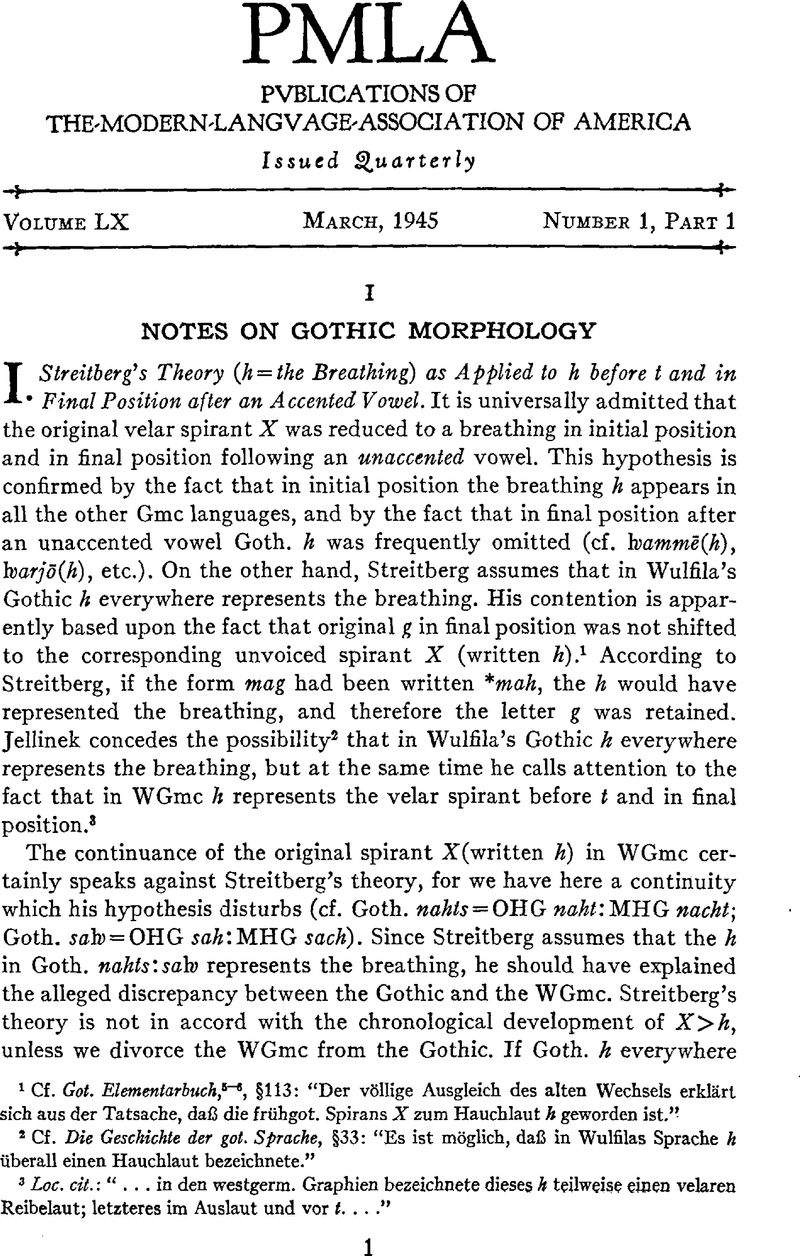Article contents
Notes on Gothic Morphology
Published online by Cambridge University Press: 02 December 2020
Abstract

Information
- Type
- Other
- Information
- Copyright
- Copyright © Modern Language Association of America, 1945
References
1 Cf. Got. Elemenlarbuch,5–6, §113: “Der völlige Ausgleich des alten Wechsels erklärt sich aus der Tatsache, daß die frühgot. Spirans X zum Hauchlaut h geworden ist.”
2 Cf. Die Geschichte der got. Sprache, §33: “Es ist möglich, daß in Wulfilas Sprache h überall einen Hauchlaut bezeichnete.”
3 Loc. cit.: “… in den westgerm. Graphien bezeichnete dieses h teilweise einen velaren Reibelaut; letzteres im Auslaut und vor t….”
4 Unless, of course, we assume with Streitberg (Got. Elementarb.5–6, §25) that in Wulfila's Gothic the spirants b, d had already everywhere been shifted to the corresponding stops. It is certain, however, that in Wulfila's Gothic the d after r had already been shifted to the stop d. The priority of the dissimilation over this shift cannot be proved. Furthermore, it is probable that the shift of spirant to stop after the liquids l and r occurred before the time when the voiced spirants were shifted to the corresponding unvoiced spirants in final position (cf. the shift of spirant to stop after nasals in PGmc mb:nd).
5 Saiws* occurs only in the dative singular form saiw-a (Luke v, 1, 2) and in the genitive plural form saiw-ē (Urkunde von Neapel). But it may safely be assumed to be an i-stem, otherwise we can hardly account for the i-endings in OHG (sēw-i: sēw-im:sēw-iu) and for the i-umlaut in OE s. Cf. Braune, Ahd. Grm.5, §216, Anm. 5.
6 Snaiws occurs only in the nominative singular form, but in North and West Gmc it belongs to the a-declension (cf. ON snær:OE snäw: OS-ORG snēo: OFris. snē). The long-stem masculine wa-substantives are confined to aiws and snaiws, and it is therefore possible that the original wa-stem saggws (cf. ON s⊖gr: OS-OHG sang, masc.) followed the example of saiws:aiws (saggw-im:saggw-ins) because of the formal congruity of the stems aiw-:(s)aiw-:(sn)aiw-.
7 Cf. also the fem. ti-abstract wist-s (laist-im:wist-im, Sk. ii, 22). Laists and lists are etymologically connected.
8 Cf. ON armr, OS-OHG arm; ON barmr, OS-OHG barm, all a-stems.
9 Cf. op. cit., §244, Anna. 3: “Man könnte daran denken, dass der Akk. Grcōs als Nom. missverstanden wurde.”
10 Cf. nom., Cor. xii, 13; acc., John vii, 35; gen., John vi, 35, xii, 20; Cor. i, 24, x, 32.
11 Streitberg, “Zur Flexion der gotischen Fremdnamen,” Festschrift für Eugen Mogk (1924), explains (p. 442, Anm. 1 to p. 441) the form Krēkōs as due to the early tendency for Lat. names to be taken over into the a-declension, but he does not explain why of all these names only Krēkōs appears in the plural form of the a-declension. He postulates for Rūmōneis (Lat. Rōmānī) a nom. sing. form *Rūmōns, but for this form we have no evidence.
12 Cf. F. Kluge, Urgerm.3, §181: “… so entstand neben dem Partizipium ahd. gimalan ‘gemahlen’ ein altes to-Participium, das noch in got. mulda ‘Staub’ steckt.” For the -d-in kal-d-s cf. op. cit., §182, d. It must be noted, however, that slaúhts represents a haþax legomenon and therefore the possibility of an “occasional” formation must be taken into account.
13 Bethge suggests (Dieter's Laut- und Formenlehre der altgerm. Dialekte, §348, 2, Anm. 2) that the connective vowel -i- may go back to an i-adjective *þiuþs as represented by ON þýdr < *þeuþiz. But since the Goth. adjective þiuþs never appears with the j-suffix, Bethge's suggestion has no factual foundation, although his inference may be correct. My hypothesis is offered as an alternative solution.
14 The compound *þiuþ-a-qiss was evidently based upon the verbal phrase þiuþ qiþan; cf. þiuþ-sþillon ∊αγγ∊λíζ ∊σθαι:*þiuþ-a-qiss ∊λγíα.
15 Cf. the substitution of final for phonetically correct * in sah, due to the medial of the paradigm:sa:sē–um, etc.
16 Cf. the NHG substitution of the s-ending in the consonantal stem OHGnom. vater:gen. vater > MHG vater:vater(s)> NHG Vaters, in order to differentiate the genitive from the nominative case.
17 Cf. Das schwache Präteritum, 48, Anm. 1: “Die Form ist namentlich insofern von Interesse, dass sie lehrt, dass die Verba auf -atjan … ihr Präteritum ursprünglich ohne Mittelvokal bildeten.”
18 Cf. op. cit., §46, 50: “Ja es scheint nicht unmöglich, dass unter Umständen auch im einfachen Wort der Hauptton vom Anfang wegrücken konnte. So würde sich die Synkope des -a- in jainpro, ‘von dort,’ jaindre ‘dorthin’ aus *jdinaþró, *jàinadré erklären. Der Gegensatz der Bedeutungen würde die Betonung der differenzierenden Elemente bewirkt haben; vgl. nhd. dialektisch herein, hinein.”
- 1
- Cited by

